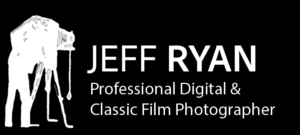KANATA PROFESSIONAL PHOTOGRAPHER/BLOG POST/FASHION/OLD PHOTO REPAIRS RESTORATION/MATERNITY/FAMILY/FAIRIES/MUSICIAN ORCHESTRA/HEAD SHOTS/BUSINESS PORTRAIT/BALLET/OTTAWA,STITTSVILLE, RICHMOND, BARRHAVEN, MANOTICK, ORLEANS, JEFF RYAN
KANATA PHOTOGRAPHERS BLOG, PROFESSIONAL PHOTOGRAPHY JEFF RYAN, NATURE PHOTOGRAPHY, CHILDRENS FAIRY PICTURE PORTRAIT PHOTOGRAPHER SERVIING OTTAWA, STITTSVILLE, RICHMOND, MANOTICK, BARRHAVEN, NEPEAN, ORLEANS
JANUARY 2022
Hello Ladies & Gentlemen:
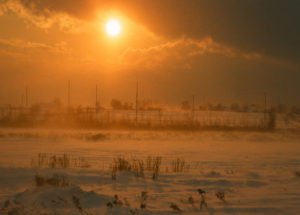
FIRST & FOREMOST … “HAPPY NEW YEAR TO ALL OF YOU” !!!
Please Accept “MY BEST WISHES” For Your Personal Happiness This Year Despite Our On Going Struggles Re: Covid. I realize that many of us frequently feel like we are fighting an uphill battle but things are getting better, day by day. I am a very optimistic man by nature. I wish to suggest that you try your best to “channel your energy” towards positive thoughts whenever you feel like your drifting towards negative situations. It takes practice but you will succeed at this and it becomes a very good habit that will change the circumstances of your life! Negativity is nothing less than the destruction of opportunities. Have fortitude but use it sensibly as you move forward in these awkward times. See my closing comment at the articles end.
*I have included some winter “FILM PHOTOGRAPHY” imagery I have created as a companion to this blog/article. I hope when reading through the accompanying text you will have the ability to correlate my thoughts with the included photographs. I will also provide you with a brief description below each image which hopefully will get you thinking in many directions. Thank you.
**The image above of a winter sunset was made in remarkably difficult conditions. The temperature was nearing -38 degrees Fahrenheit accompanied with excessively high winds making my tripod mounted camera difficult to steady. I tried to secure any movement in between gale like wind gusts that were changing my position and footing constantly.
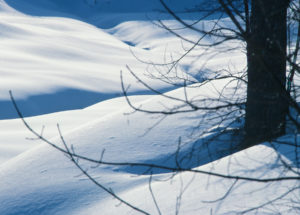
This month provides a great opportunity to indulge in several areas of activity including photography. Activities being, skating on the Rideau Canal or elsewhere, skiing, snow shoeing or arriving at destinations depicting landscapes, forestation etc. Photography of these aforementioned areas can be very fulfilling. I am not one to carry a camera with me while I am skating or doing any other physical activity simply because of the risk of falling and creating damage to my gear. In addition, compositions will not be orchestrated properly given the random approach to quick image capture photography. I would think that people who are more serious of creating meaningful images would be visiting these areas with a tripod and giving thought to the creation of each frame.
*The photograph above, (as are all the colour images in this blog) were created with professional transparency-(slide) film. The above image represents how depth of field comes into play. With a wide aperture setting on my camera of F4, objects that are close or farther away from my point of focus are thrown out of focus in an intentional manner. Using techniques such as this, a photographer can direct a persons attention to specific areas of the photograph. If the image had been created using an aperture of F16, F22 for example, the entire image would be relatively sharp from foreground to background.
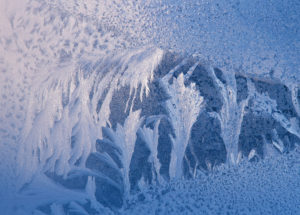
The frost patterns above were created in a previous residence that had poor fitting windows. Commonly I would awake to excessive frost accumulating on the glass overnight. Fortunately, the rising sun was able to gently touch the window depicting beautiful patterns of ice comparable to those beneath my skate blades on the canal. This photograph was created with a Macro/Micro close up lens and the exposure was set at F22 for maximum definition.
***You will notice throughout this article a consistent tonality of blue in several images. This is a regular occurrence when photographing in winter.
Winter photography as mentioned in a previous blog post can be awkward for camera enthusiasts due to the extremities of cold weather. Temperatures often cause people to miss visual occurrences by keeping them in the comfort of their homes. As hard as it may be, I would encourage you to make a choice to rise early and seek a location that affords a beautiful view of areas where you can capture a sunrise over open water or otherwise. I have frequently headed out in early morning with temperatures hovering at -25 degrees or comparable. Layers of clothing is an absolute necessity without question to maintain levels of comfort so you can concentrate on the scene presented to you as opposed to being overwhelmed by shivering in the cold. I mentioned previously in a former blog about operating your camera equipment in severe winter conditions, and a friendly reminder of keeping your camera protected from direct snowfall is important. Bring with you additional batteries! They often drain at accelerated rates in frigid temperatures and please purchase replacements from your camera manufacturer. Generic batteries don’t have the same levels of endurance that the manufacturers products do. They typically cost more but in the long run are well worth it.
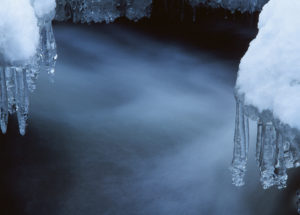
In studying winter landscapes, depending upon what time of day you are creating imagery, you will often notice on a clear day the colour of blue (as mentioned above) often takes precedence. This colour reflecting in the shadows of your scene can be either a welcome addition or something that you have the ability to remove “while the image is being created” as opposed to doing colour temperature correction in photo shop afterwards. Ultra violet or skylight filters designed to reduce blue in areas are classified as daylight/UV filters, and or slight warming filters. They more or less subtract blue from the scene making your pictures look more acceptable and realistic. It is a personal choice if you wish to incorporate these colours in your imagery to either compliment your photograph or detract from it. Filters specifically designed as “warming filters” will alter the scene considerably giving it a more warmer toned effect and will cancel the bluish hue from the scene.

On those cold mornings when I am out I find often that controlling one’s exhaled breath becomes another item in cold weather photography that you have to control. Many times exhaling close to your camera will fog or cause frost on your viewfinder, and if you are within close proximity of the front of your camera lens, fogging of the lens will also occur. I have had to at times utilize a self timer feature giving me sufficient time to distance myself from my camera allowing the viewfinder and or lens to clear prior to releasing the shutter. Self timers or long cable releases can be a very beneficial tool to alleviate these circumstances.
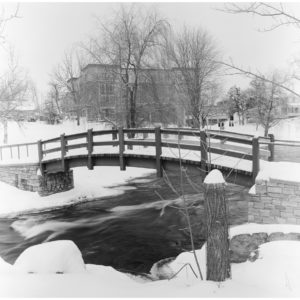
*The black & white imagery included in this blog was made with ILFORD FP4 120 format professional negative film, and gently hand processed in my darkroom utilizing Kodak HC-110 Film developer at 68 degrees Fahrenheit. The camera system was my Hasselblad 500CM totally manual camera. This camera does not include a light meter or any batteries. Light metering is done by hand, utilizing either a Pentax 1 degree Spot Meter or a Minolta Flash Meter 4 with a 5 degree spot attachment set in reflective/incident metering mode.
It is difficult for photographers in this time period were in to have cameras that are completely manual in operation with the exception of having a built in light meter. The digital products typically thirst for battery power. My suggestion when using a digital product in the winter field is to ensure you have fully charged main and back up batteries and that you “turn off” your viewing screen located on the rear of your camera. You really do not need to view each image on a monitor. If you have created a good composition and have made exposure decisions to produce excellent exposures you should feel comfortable not being so dependent upon “instant viewing” of imagery.
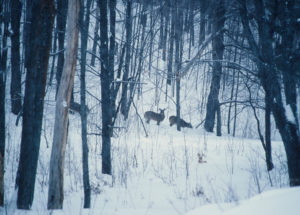
*Remember”…..film cameras never included viewing screens, and photographers for years have produced award winning imagery without them! Break the habit of dependency on these screens and concentrate more on compositions and exposures! By doing so, you will gain a much, much better knowledge and thought process of photography when standing behind your camera. Think things through prior to actually snapping the shutter. I often reflect back to the days when film was the primary tool for photographers. One of the reasons behind this was that the cost of purchasing film and paying for processing came out of photographers pockets. Each time they purchased a roll of film, there was a cost to them for each frame that went through their cameras,therefore making informed compositions a wise decision. When they created imagery with negative film during the developing stages, they paid for the processing of that film and “only” for the imagery on the roll that was exposed. For instance, if they exposed 10 frames on a 24 exposure roll of film, they would only be charged for the 10 images and nothing else. Transparency film was addressed differently meaning, a flat development fee was charged for the entire roll regardless of the quantity of exposures created.
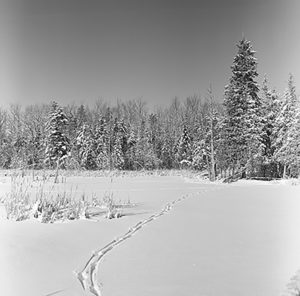
I mention this price analogy because I have encountered far too many people interested in photography using digital cameras who “feel the need” to exposure dozens and dozens of images hoping to get one right. If they were using good camera handling techniques and thoughtful composition/exposure equations they would be exercising much better camera practices. Try to imagine the next time you are doing photography that you have to pay for each individual frame that is exposed in your camera. “Create a disciplinary system for yourself”. You are going to find that by doing so, at the end of a days photography session, you will bring home far less imagery, but ones that carry significant weight as opposed to numerous of non important images lacking structure. Take the time to study your subject as it is in your viewfinder! Obviously, depending upon what your photographing dictates your levels of efficiency. Photographing moving objects or simply creating candid snapshots is a different medium entirely, but when you have the time, treat yourself and your camera wisely. Bringing home 10 or less excellent compositions from a days session in comparison to 100 plus rejections will be your own reward of excellence.
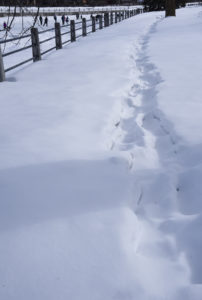
CLOSING
In closing, being a person of strong religious convictions, I often recall the poem titled “Foot Prints” when viewing scenes such as these two photographs above. If your unfamiliar with these spiritual writings, I would recommend them very highly. I would also like to include these beautiful, moving quotations written long ago but still gather tremendous significance and substance in todays realm:
“Pray as if everything depended on God. Work as if everything depended on you”.
“Commit thy works unto the Lord & thy thoughts shall be directed”.
“Superstition is but the hunger of the soul for an active knowing belief in God”
With My Good Wishes Extended, Happy New Year,
Jeff Ryan Photography/Ryan Studio Ottawa
www.jeffryan-photography.com
